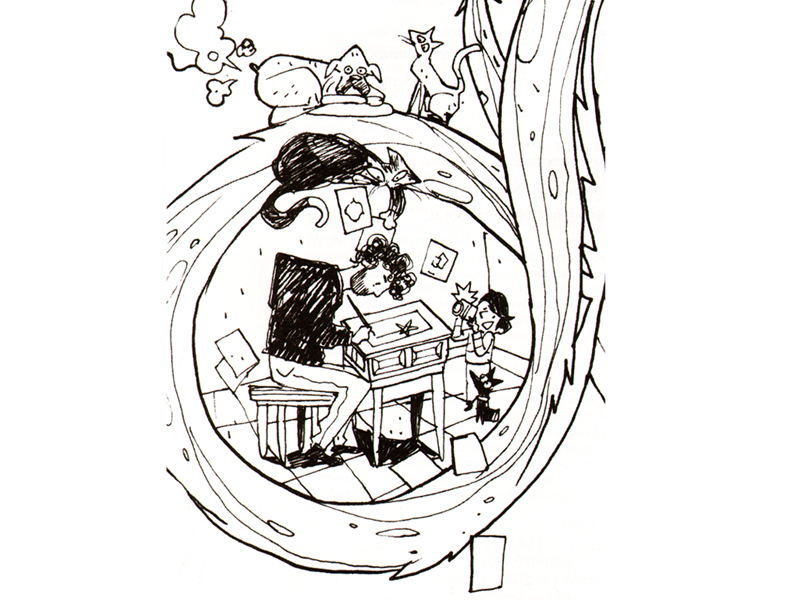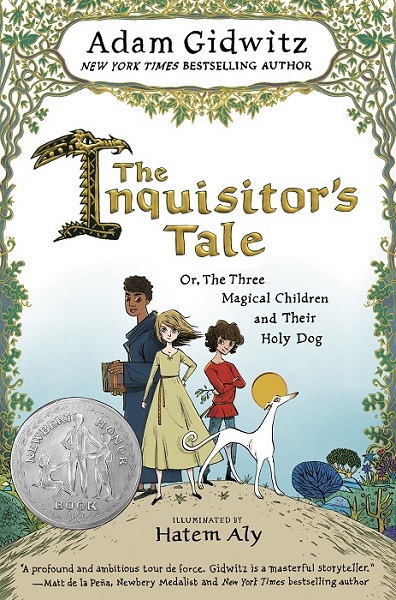
The Inquisitor's Tale: Or, The Three Magical Children and Their Holy Dog (most recently published in English by Puffin Books in 2018; ISBN 9780142427378), a young adult novel by the American writer Adam Gidwitz, is set in medieval France. It was named a Newbery Honor book in 2017. Papmambook’s teenage authors share how the book changed their understanding of the Middle Ages.


Anna Semerikova, 12
The Middle Ages are one of my favorite historical periods. I try to read many different kinds of books about this period, whether they’re encyclopedias or historical fiction. The narrative in these books often flows smoothly, unspooling gradually, like a ball of yarn. Recently, however, I got my hands on a book that changed my idea of what historical fiction can be. It was The Inquisitor’s Tale: Or, The Three Magical Children and Their Holy Dog by Adam Gidwitz. “Wow!” I thought to myself. “There are holy dogs?“ Right away, I wanted to learn more.
Reading this novel was like unraveling a mystery. Each chapter is the story of one of the patrons who come to the Holy Cross-Roads Inn to while away a long rainy night over rounds of ale. Knights, monks, troubadours, students, friends of the King of France himself, and finally, the Inquisitor. At one point or another, they’ve all crossed paths with three remarkable children and their dog, but each storyteller knows only one small part of their adventures, so each tale breaks off on a cliff-hanger. Some think the children are saints, others consider them to be heretics that need to be caught and killed, because they have been acting so strangely. With each new turn of the plot, we dive deeper still into the colorful medieval world. You can never guess what to expect in the next chapter. The book’s illustrator Hatem Aly helps create this effect. He calls himself an “illuminator,” like in the Middle Ages. I used to think the word meant only the window in a submarine. But here, too, we have a window—a window into an era.
It’s 1242. France. King Louis declares war. Not on an army, but on three kids and their dog. The first of these enemies is William, the young, black oblate from a Benedectine monastery, the son of a knight and a beautiful African woman. He can read Latin and knows theology. Then there’s Jacob, a small Jewish boy who heals mortal wounds and saves the sacred Torah from the fire. Finally, Jeanne, a young peasant girl who has visions, and her snow-white dog Gwenforte. Rather unexpected heroes for a medieval novel, right? I already knew from other books that at the time blacks were treated with fear and prejudice, Jews were hated because people thought they were responsible for killing Christ, and those that saw visions could be declared witches or wizards and burned at the stake. So the children were doomed from the start. They meet out on the roads of France, fleeing from their persecutors, and become fast friends. They love books, even Jeanne, who is illiterate. One day they learn that the King of France has ordered that all the sacred Jewish texts in Paris be burned in the square. William compares destroying a book to destroying a life. And so they decide to challenge the King himself….
Now this is what I find strange. If, for medieval Europeans, life revolved around their Christian faith, how could they also hate, destroy, and kill? It feels like the book’s author, Adam Gidwitz, also set out to answer that question. He tries to reconstruct the way people thought back then and show that, on the one hand, it was completely normal to believe in dragons and giants (Jacob fights one), or that a dead dog can come back to life and return to its owner. On the other hand, people were terrified of anything that was new and unfamiliar, and they tried to protect themselves against it with all their might. That may explain why the people of the Middle Ages divided others into two groups—“us” and “them”. They helped and supported those who were like them and drove out and persecuted others. An outsider didn’t even count for a person, which meant that Christian ideals of mercy didn’t apply. This made the world safe and predictable. People had no problem attending mass, wearing a cross on a knight’s mantle—and persecuting those who were unlike them.
Luckily William, Jacob, and Jeanne weren’t anything like the narrow-minded adults around them. They were able to overcome stereotypes common to their time, and helped each other gladly. They didn’t have religious or national barriers. They simply lived and were happy despite their desperate situation. It’s not all that easy to live when the king himself is after you. Even so, they were able to find strength within, not just to save the ancient books, but even their pursuers, when the latter were in mortal danger. The children of this story showed themselves to be much more wise and compassionate than the adults that surrounded them.


Ksenia Barysheva, 14
At school, when we study the Middle Ages, we also learn that they were the “Dark Ages” in the history of Western Europe. Textbooks tell us that science and art were at a standstill, scientific treatises were destroyed, and those that believed that the Earth revolves around the Sun (rather than resting on three whales) were persecuted. Anatomy, as a science, was banned, and many women were burned at the stake, accused of being witches by the Inquisition. In reality, it was all a bit more complex. If it were all so bad, the Renaissance would not have followed, and there wouldn’t be anything left of ancient tradition for us to make sense of today. Among the people of that time were those who preserved the wisdom passed down from the ancients, copied out ancient treatises, and studied the works of scientists from the Near East, where science was developing more freely. There were also those who wrote their own scientific and philosophical works. It’s this other side of the Middle Ages that Adam Gidwitz presents in his book The Inquisitor’s Tale.
The Inquisitor’s Tale is an entertaining adventure novel about medieval France under Saint Louis IX, King of France, and three children who meet by chance on their way to the Abbey Church of Saint-Denis. In the course of a week, they are held prisoner at the castle of a large landowner, fight a dragon, become guests at the King’s table, and then are declared enemies of the state.
A group of people gather at a roadside inn. By chance, some have become witnesses to the events that befall the children. Several know the peasant girl Jeanne, others have come across William, a black oblate, still others have crossed paths with a young Jewish boy named Jacob. What happens to the three children is so unbelievable that each of the narrators, as he tells his part of the story, tries to prove his own connection to the unlikely tale. All along, there’s someone at the inn, listening from the corner, topping up the ale in each mug, asking questions about the children, and taking in every tiny detail. Why does he need to know the story of the strange trio? Is it mere curiosity that drives his questioning? What is it he wants—to help the children escape the King’s knights? To kidnap the children and get ransom? Or has he been sent on another mission? The mysterious stranger bides his time and once the patrons have left the inn, continues to wait in his corner. He understands why the children, whose journey started at the inn, must return to this place.
Each chapter of the book is the story of one of the inn’s patrons, and each knows only part of the whole story. The reader follows in the young heroes’ footsteps, until, like the mysterious stranger, who has been sent by the Inquisition, he comes face to face with them himself.
While working on the book, Adam Gidwitz spent a lot of time in archives in Western Europe, studying medieval records. Many parts of The Inquisitor’s Tale are based on facts from real historic sources. The travelers gathered around the table at the roadside inn hear the true Lay of Hildebrand that has been passed down from that time. The story of Jeanne, the peasant girl, is reminiscent of the story of Joan of Arc. William, the black oblate, is like William of Gellone, the true historical figure who became the hero of many legends. There isn’t a specific prototype for Jacob, but 20,000 copies of the Talmud were actually burned at the Place de Greve in Paris in 1242. As for the dragon that ate too much cheese, the author took the episode from the life of Saint Martha, while the story of Abbot Hubert about the friend who led him to the brink of Hell is from the chronicles of William of Malmesbury. The story of Gwenforte, the holy dog, is from the diary of real-life inquisitor Stephen of Bourbon.
Adam Gidwitz unfurls a broad panorama of life in medieval Europe before his readers and describes the typical fates of the people who inhabited it: peasants, rich landowners, nobles, monastic clergy, younger sons who were denied an inheritance and chose to set off on adventures…. In the Middle Ages, people didn’t feud with others based on their national origins. Instead the dividing line that determined who was “us” and who was “them” was religion. It’s important to note that the main characters of the book have different ways of speaking. Jeanne speaks simply, as peasants did, William expresses himself pretentiously in the language of Latin erudition, and Jacob’s speech is peppered with quotes from religious books.
For the reader that knows of the Middle Ages from school textbooks, The Inquisitor’s Tale is a fresh glance at the time period, an opportunity to see living people, understand their ways of thinking, what was important to them and what was not. The three heroes of the book are serious when they discuss that to become saints they need to die, sacrifice themselves, and complete their mission no matter what—trying to save at least one copy of the Talmud from the burning. Death itself does not frighten them in the least, since they believe that after death a new, better life will begin.
This way of thinking was not unusual in the Middle Ages. People who lived back then almost never had their birthdates registered, because the event wasn’t considered important. But their date of death was strictly recorded.
Intrigued by the events and historical figures described in the book, I learned several more facts that help to understand the way of thinking back then and to take a fresh look at the events of medieval history.
After his death, King Louis IX was declared a saint. Immediately after the sovereign’s canonization, his friend Jean de Joinville (one of the men who talks to the mysterious stranger in Gidwitz’s book) demanded that he be given the king’s finger as a holy relic. His request was honored and Joinville kept these hallows until his very death, as his personal ticket to eternal life.
Little Jeanne, one of the protagonists of The Inquisitor’s Tale, was shocked when Theresa, a woman in her village was accused of witchcraft for healing people with herbs. Monk Michelangelo di Bologna came to take her to the monastery to be tried for witchcraft. As it turns out later, by sending Theresa to a monastery, the monk saves her from the secular courts. This story could very well be true: church courts, the courts of the Inquisition, considered witchcraft a much lesser sin than religious heresy. There are historical records of cases when the Inquisition acquitted those who were accused of witchcraft. Archival documents describe a case when one of the inquisitors (to be fair, this was much later, in 1614) investigated accusations of witchcraft. He compared and found inconsistencies in the villagers’ accounts about how an accused witch flew to a coven. Then he took the ointment, which according to witnesses, the woman applied before flying off, and rubbed it on a dog, but the dog didn’t fly. He gave the dog a potion, which the “witch,” as the neighbors claimed, used to curse pets. Once again, the dog was unharmed. And so the woman accused by her neighbors was acquitted.
The novel’s illustrations are the work of “illuminator” (the medieval word for illustrator) Hatem Aly. His self-portrait with his pets is on one of the book’s pages. Some illustrations match the text, but in others the artist gave his imagination free rein and drew things that weren’t in the book—just like the medieval illuminators decorated manuscripts 800 years ago.
Translated from the Russian by Alisa Cherkasova
Book cover image: penguinrandomhouse.com
Follow us on Facebook.
